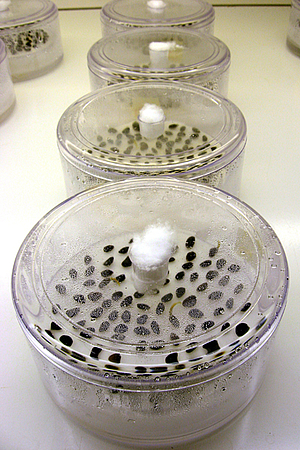Use and transfer of forest reproductive material

Forest regeneration may be natural or artificial. Both depend on forest genetic resources, but while natural regeneration relies on what is already available on a given site, artificial regeneration often makes use of the deliberate transfer from elsewhere of forest reproductive material (FRM). This material may be in the form of seeds, seedlings or cuttings.
The selection of suitable FRM has assumed a new importance both because trees are long-lived species and because rapid climate change will have an impact on the environmental conditions of the trees as they grow and mature. The long-standing importance of FRM to forestry and the cross-border trade in FRM have resulted in several European countries exercising some control over sources of FRM and their selection. Climate change is one reason why countries need to re-evaluate and modify their policy framework and guidelines on the use of FRM. An important additional practical challenge is that to an unprecedented degree forest managers must now consider the climate that a new generation of trees might experience in future, in order to select material that will thrive now, under the present climate, and also be able to withstand predicted climate. Furthermore, many forest owners think of FRM as a cost to be minimized rather than as an investment for which they should be seeking better returns.
Against this background, a working group under EUFORGEN was tasked to report on the use and transfer of FRM to respond to the challenges of climate change. The working group examined scientific research on provenance and adaptation, including several case studies of transfer, the existing regulatory framework and recent policy developments, guidelines on FRM transfer and their scientific basis, and future challenges and opportunities. The group concluded that:
- Transfer of FRM is a valuable option to adapt forests to climate change, although there may be limits to the transfer of FRM.
- Local provenances may not always be the best source of FRM.
- Before considering changing tree species, forest managers should consider deploying other, well-tested provenances of the existing tree species. At the European level, recommendations on FRM transfer must be revised and harmonised and at the same time, all stages of production and marketing should be more stringently controlled.
- Tree breeding also offers opportunities to assist forests and forest management to adapt to climate change.
- Improved documentation is crucial to ensuring that today’s use of FRM can inform tomorrow’s choices, just as past efforts have helped to guide today’s recommendations.
- Basic research on adaptation of forest tree populations, along with provenance research, should continue and be strengthened, and the results disseminated in forms that forest owners and managers and policy makers can use.
 | Use and transfer of forest reproductive material in Europe in the context of climate changeThe selection of suitable FRM has assumed a new importance both because trees are long-lived species… |
Download |
